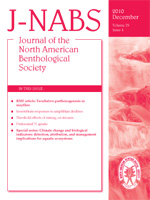Climate change is expected to alter freshwater communities and accelerate extinction, but the exact processes are poorly known. Here, we appraise interannual variation between 2 sympatric planarians (Crenobia alpina and Phagocata vitta) in upland Welsh streams over 25 y during which 1 of this pair (C. alpina) disappeared. We tested 3 nonexclusive hypotheses involving: 1) long-term changes in stream chemistry, 2) interspecific competition, and 3) climatic variation or directional change to explain this apparent local extinction. Several lines of evidence revealed potential exploitation competition between C. alpina and P. vitta. Coexistence was confined to conditions with high prey abundance (recorded as the abundance of Ephemeroptera, Plecoptera, and Trichoptera) and summer temperatures <12.5°C, whereas P. vitta dominated at sites with higher temperature, greater discharge, and lower prey abundance. The loss of C. alpina in the Llyn Brianne experimental catchments coincided with the largest-ever positive amplification of the North Atlantic Oscillation (NAO) in 1989 to 1994, accompanied by increased stream temperature, increased winter discharge, 2 summer droughts, and markedly reduced prey abundance. We suggest that interspecific competition and this prolonged climatic event acted in concert to favor P. vitta over C. alpina. Since its local loss, summer stream temperatures have generally exceeded the favorable range for C. alpina and, coupled with weak dispersal ability, probably explain its continued absence. Our data are consistent with the prediction that extreme climatic events will affect small, fluctuating populations. Nevertheless, this case study demonstrates clear difficulties in identifying unequivocally the exact climatic processes causing extinction where: 1) evidence is confined to weak inference, 2) responses to complex climatic events are nonlinear, 3) interactions occur among species or between climate and ecological processes, and 4) assessments are made retrospectively following extinctions.
How to translate text using browser tools
26 October 2010
Evidence for the role of climate in the local extinction of a cool-water triclad
Isabelle Durance,
S. J. Ormerod
climate change
freshwater
NAO
planarians
streams
temperature
Wales





